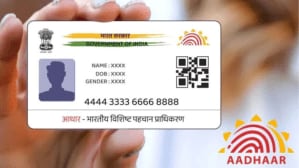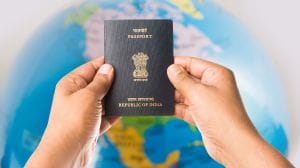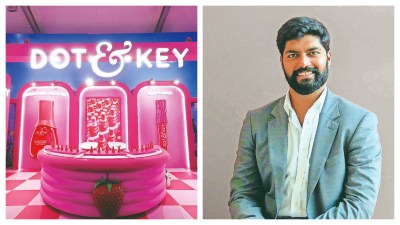On February 20, the Indian National Congress (INC) put out a cheeky meme—a parody of Prime Minister Narendra Modi— on the trending Hindi song Chor. In the short video, Modi’s face is seen superimposed on that of the singer, who also sings in the PM’s voice to lyrics rewritten to the idea of chor, or thief. The chor here is a business tycoon, to whom Modi hands over ports, coal mines, forests and, ultimately, the country, as the lyrics of the parody goes, criticising the PM’s alleged close links with the billionaire businessman. “Don’t know about 2024 but clearly you guys have won the meme fest,” a user commented on the short video that has amassed over 1.5 million views and counting on Instagram.
While the impact of artificial intelligence (AI) on the upcoming Lok Sabha elections remains a concern, political parties are trying their hands on the new technology, integrating it into electioneering in novel ways, furthering their messages and connecting with voters, while taking down the opponents.
On its part, the Bharatiya Janata Party (BJP), too, recently put out a short video, this time featuring Rahul Gandhi with the face of the Congress leader superimposed on that of Rashtriya Janata Dal (RJD) leader and former Bihar deputy CM Tejashwi Yadav. In the original video, Yadav takes down Bihar CM Nitish Kumar for abandoning the Opposition alliance in the state and rejoining the BJP-led National Democratic Alliance (NDA). However, in the parody video, Gandhi is shown addressing West Bengal chief minister Mamata Banerjee, as the Trinamool Congress announced candidates for all 42 Lok Sabha seats in the state. “Ek baar bata to dete aap, iss baar to aapne kuch kaha hi nahi (You could have told us once, this time you didn’t even say anything),” Gandhi is shown saying, implying a fallout in the Opposition’s INDIA bloc ahead of the elections.
While this unfolded on social media, several kilometres down south, M Karunanidhi, the Tamil political stalwart, appeared live on screen before an audience, earlier this year. Wearing a white shirt, a yellow shawl, and his trademark black sunglasses, the doyen of Dravidian politics was seen congratulating his fellow Dravida Munnetra Kazhagam (DMK) politician TR Baalu (82) for his book, and also praising his son and Tamil Nadu CM MK Stalin for his leadership. Only that Karunanidhi died in 2018.
“I didn’t anticipate this thing to absolutely blow up,” says Senthil Nayagam, founder of Muonium, the AI media-tech startup, which resurrected the leader using artificial intelligence. Here, Nayagam specifically chose to go with the younger version of the leader, and not the years right preceding his death, when he was in his 90s. “I used the publicly available data of Karunanidhi from his younger days, when he was an aggressive speaker, to train the speech model, and recreate him,” Nayagam tells FE, highlighting that AI can be used to resurrect any dead leader, from Mahatma Gandhi to Subhas Chandra Bose, whose speeches are publicly available.
Tamil Nadu’s ruling DMK is bringing back dead leaders and so is the Opposition All India Anna Dravida Munnetra Kazhagam (AIADMK), which on the 76th birth anniversary of its iconic leader J Jayalalithaa, last month, brought out an AI-generated audio clip of the former chief minister, in which she seeks support for party leader Edappadi K Palaniswami, for the upcoming Lok Sabha polls. “Makkalal naan, makkalukkagave naan (I am because of the people, I am for the people),” she is heard saying in her signature voice.
Resurrecting dead leaders is one thing, politicians are also using artificial intelligence in different ways to reach a wider audience—those they couldn’t directly address due to language barriers. This was witnessed at the Kashi Tamil Sangamam in December last year, when the prime minister’s speech was directly translated into Tamil to reach the Tamil-speaking audience. “This is a new beginning and, hopefully, it makes it easier for me to reach you,” he had said once.
To that extent, the ruling BJP has also started translating Modi’s speeches into four south Indian languages—Tamil, Malayalam, Kannada and Telugu— besides Marathi, Bengali, Odia and Punjabi, as per media reports. It has also made separate Twitter handles for the individual languages, too, for Modi’s speeches. The fact that four of the eight languages are those of southern states indicates the party’s outreach in the region, where it has struggled to get foothold on, sans Karnataka. Also, Maharashtra and West Bengal have the largest number of seats in the Lok Sabha, after Uttar Pradesh.
So can AI play a pivotal role in deciding the fate of parties in the upcoming elections? “It’s not much about swaying elections, but about increasing the reach of a leader. Having said that, it doesn’t give a unique advantage to any one party as the technology is available to everyone for use,” says Amitabh Tiwari, a political commentator and poll analyst. “However, the BJP is an early adopter of tech, which can give them a first-mover’s advantage,” he says.
According to Nayagam, the BJP is now looking at translating speeches of leaders like Udhayanidhi Stalin made in the past, on issues like the Ram Temple, those made in the local language, which earlier nobody other than the Tamil-speakers had access to. “And it isn’t restricted to the present leaders, you can go back ages, and take speeches of leaders like Periyar, and translate them into other languages,” he says, highlighting the role AI can play in breaking the language barrier.
While we’re witnessing a profound use of AI in the run-up to general elections, “it isn’t the first time that the tech is being used in polls,” says Divyendra Singh Jadoun, the founder of Ajmer-based The Indian Deepfaker. During the recently-held Rajasthan Assembly polls, the firm cloned the voice of Ashok Gehlot, the CM candidate of the Congress in the state, to send personalised messages on WhatsApp, addressing voters by their name, as per a media report.
“Automated calls by political parties isn’t a new thing. However, these felt like customer care calls, and hence, voters would disconnect. So what AI does is making it a real-time conversation that’s two-way, where the leader addresses the voters by their name, which gives it a personalised touch,” Jadoun tells FE.
The upcoming election season is a busy one for the Ajmer-based techie, as he’s working with parties, aiding them with AI add-on, and furthering their campaigning.
A project that Jadoun’s firm is currently working on is personalised messaging “not for voters, but for the party workers.” In the personalised message, the leader addresses the worker by her name, and commends them for their work, he shares. “If you consider political party a company, it’s the only company where the employee, works for free. So what these workers look forward to is recognition from the leadership,” Jadoun comments.
While the cost of a project can depend on several factors, a project can easily bring business anywhere from a few lakhs to crores, says Nayagam. “The personalised messaging can cost them anywhere between Rs47 lakh and Rs 60 lakh,” said Jadoun. The likes of Nayagam and Jadoun are looking at big business, as the AI-facilitated content marketing for electioneering is expected to be market opportunity worth $60 million this election year in India, an international media house reported quoting the director
of a leading Indian political consultancy.
While there is an opportunity, there are also concerns over what can be termed as the unethical use of AI in political campaigning, requests for which both Nayagam and Jadoun get often.
And examples of such acts are present galore. As people queued up to vote in the Telangana Assembly polls in November, KT Rama Rao, the working president of the Bharat Rashtra Samithi (BRS) and son of former CM K Chandrashekar Rao, fell prey to deepfake. In the video, shared by the Congress on X, the leader was shown asking people to vote for Congress, and against his party. While the impact of the video cannot be gauged, the Congress, along with its ally, the Communist Party of India (CPI), won the majority of the seats in the state.
“The timing is crucial here,” says Nayagam. “Chances are that such deepfake videos will be circulated right before polling to create confusion in the minds of the voters. While it won’t have much sway over core voters of parties, it can definitely have some impact on the swing, the undecided voters,” he said.
Meanwhile, the BRS took the matters up with the Election Commission, accusing the Telangana Pradesh Congress Committee of being “involved in the creation and dissemination of fake audio and video content through the use of deepfake technology and artificial intelligence”, as per media reports.
Ahead of the Madhya Pradesh Assembly polls, Modi, too, fell prey in a somewhat similar fashion, as he was seen doing Garba with a bunch of women in a widely-circulated video. “I recently saw a video in which I was seen playing Garba. I have not done Garba since school,” the PM said at a BJP Diwali event, addressing concerns over the misuse of AI. In another deepfake video, actor Amitabh Bachchan is seen hosting the popular TV show Kaun Banega Crorepati and asking questions that shows the then-government led by Shivraj Singh Chauhan in a bad light.
At the recently-held Mathrubhumi International Festival of Letters, Congress leader Shashi Tharoor sat alongside his digital avatar, whose presentation and questions were so striking that the leader commented, “It’s slightly intimidating and worrying. Tomorrow it might be saying all sorts of dangerous things and get me landed in serious trouble … I am going to wonder whether we just had a lot of fun or whether, oh gosh, if I have opened the door to something that could be potentially dangerous and damaging. I don’t know; the jury is still out on that.”
As over 60 nations are up for polls this year, multiple studies have flagged the detrimental impact AI can have.
In its study, the George Washington University has predicted a near-daily frequency of “bad-actor AI activity” this year, which can “affect election results” in multiple countries heading for polls in 2024. Another study published in PNAS Nexus, stated that online trolls, disinformation campaigns, and other “bad actors” were set to increasingly use generative AI to stoke election falsehoods, affecting election results in more than 50 countries that are holding elections this year, including India and the United States.
We are already witnessing both the use and misuse of AI in electioneering abroad. In neighbouring Pakistan, incarcerated leader Imran Khan played on his frontfoot as he addressed supporters through his digital avatar. Far, in New York, mayor Eric Adams used AI to make robo calls to constituents, where he spoke in Spanish and Mandarin. However, in several cases, deepfakes have been detrimental. For example, a video circulated of Florida governor Ron DeSantis withdrawing from the presidential race much before he actually did.
At the Munich Security Conference last month, world’s top tech companies, including OpenAI, Google, Microsoft, Meta and Amazon, pledged to fight AI-generated election deepfakes, and that they would work together to combat content created to mislead voters. According to the accord signed by them, the swift development of AI was “creating new opportunities as well as challenges for the democratic process”, and the spread of deceptive content could “jeopardise the integrity of electoral processes,” as per reports. “With so many major elections taking place this year, it’s vital we do what we can to prevent people being deceived by AI-generated content,” Nick Clegg, Meta’s president of global affairs, was quoted as saying by media reports.
Recently, Google restricted its AI chatbot Gemini from answering poll-related queries in countries voting this year. “Out of an abundance of caution on such an important topic, we have begun to roll out restrictions on the types of election-related queries for which Gemini will return responses,” reads a statement on the company’s site.
Notably, information technology minister Ashwini Vaishnaw, in November, called deepfakes a “threat to democracy”. Meanwhile, PM Modi, too, has voiced concerns over the same.
Interestingly, it appears the BJP was the first to use deepfakes in election campaigning, and that too way back in 2020, when through his deepfake videos, BJP politician Manoj Tiwari was seen campaigning in English and Haryanvi, languages that he doesn’t speak. It clearly shows how BJP has been at the forefront of employing technology in electioneering, and it extends beyond AI and deepfake.
Digital campaigning
The 2019 Lok Sabha polls saw an expenditure of Rs 55,000 crore, which had made it the world’s most expensive election then. “Although it’s difficult to put a number to it, an approximate 5-10% of that amount goes into digital campaigning, which includes social media,” says Tiwari. “The use of social media, more so by the BJP, is very visible; and it has grown over time, party because of two factors. One, digital platforms have gotten increased reach, and Indians today are able to access digital platforms,” says Dr Sandeep Shastri, director, academics, NITTE Education Trust, and national coordinator, Lokniti Network.
The 2014 Lok Sabha polls were when a widespread use of tech in electioneering was seen, from Modi’s hologram, using which he addressed people at multiple locations, to the party having a “free run” over social media. “Rahul Gandhi joined Twitter, now X, only in 2015, but BJP had a free run on social and digital media, because nobody had envisaged that this could actually play a role,” says Tiwari.
Although late to party, other parties have also caught up spreading their presence across social media platforms, engaging with influencers, and spreading their message.
However, here too, BJP seems to have tactfully changed its strategy. “While in 2014, BJP had a free run over social media, if you do a sentiment analysis of Modi now, it will come out as negative. The party has realised that, and has shifted base, from public social media platforms, to what can be called a private one, and that’s WhatsApp. If you look at Modi’s X handle, the number of posts by him has come down significantly. So what the party has done now is it has shifted its entire communication ecosystem to WhatsApp, and made several groups run by their regional, IT, and local teams. These are used to disseminate and propagate information, and they have gone so deep with it that they can send any message across the country within a day. And these messages cannot be countered, unlike on the public social media platforms,” Tiwari explains.
While the Opposition parties have also dabbled with the strategy, the commentator highlights that stabilising WhatsApp groups take time and effort. “You cannot keep on adding anyone. Firstly, people would leave and also WhatsApp has its own policies under which it purges groups if you keep on adding people randomly,” he explains.
Having said that, the biggest question is, can digital campaigns win elections?
According to Tiwari, while digital is expanding in reach, it’s still the traditional style of campaigning that has a larger sway over elections. “Firstly, digital campaigns don’t offer a significant advantage to any one party. One party can run the ‘Abki Baar Modi Sarkar’ campaign, another can run ‘Mein Bhi Chowkidar’,” he says. “Also, social media doesn’t win you elections. They are won by leaders and party workers, who get you votes,” he adds.
Also, “social media strengthens attitude, it doesn’t necessarily change attitude,” says Shastri.
Coming back to the AI meme on Modi shared by Congress, a user comments, “Creativity level: 545, MP seats: 44,” highlighting the number of Lok Sabha seats the party won in the previous election. “Sarkar to tumse banegi nahi, memes hi bana lo (You cannot make a government, so better make memes),” reads another. “Sirf memes ki vajh se follow kar raha hun, vote fir bhi nahi dunga (I’m just following you due to the memes, I’m still not going to vote for you),” reads a third comment.









